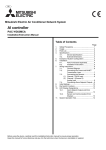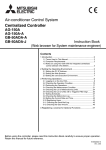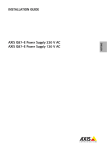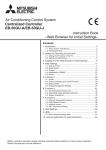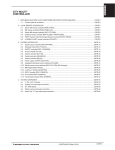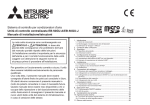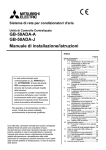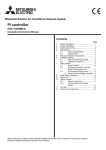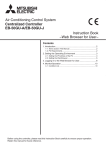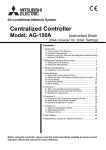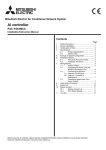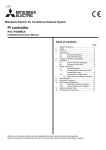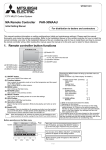Download Mitsubishi Electric PAC-YG63MCA Specifications
Transcript
3. SYSTEM CONTROLLER 3-11. AI Controller [PAC-YG63MCA] The AI controller measures temperature and humidity; it also has an alarm capability if the measurement data exceeds defined setpoints. Historical measurement data can be displayed via only the AE-200A/AE-50A/AG-150A-A/GB-50ADA-A/EB-50GU-A Web browser and TG-2000A. Temperature and humidity can be displayed on the AE-200A/AE-50A/AG-150A-A LCD. Furthermore, an alarm can be output if measurement data exceeds a preset upper or lower limit. The AI controller also features a function that interlocks M-NET devices for indoor units, etc. 26 (11/32) External Dimensions 46 (113/16) 200 (77/8) 150 (529/32) 45 (125/32) 9 (3/8) 4.5 (3/16) Al controller PAC-YG63MCA [ OUTPUT ] Non-voltage Contact Output Ch1 Ch2 Alarm Alarm N623 Al controller PAC-YG63MCA MODEL SERVICE REF. PAC-YG60MCA-J This device complies with Part15 of the FCC Rules.Operation is subject to the following two conditions: (1)this device may not cause harmful interference, and (2)this device must accept any interference received, including interference that may cause undesired operation. IN JAPAN Ch2 83.5 (35/16) 15 CAUTION CNTR-66 [ 24 VDC Power Supply] 4 to 20 mA / 1 to 5 V / 0 to 10 V (19/32) 26 (11/32) Ch1 4 to 20 mA / 1 to 5 V / 0 to 10 V 0.6 kg / 13/ 8 lb SERIAL No. MADE 27 (13/32) Unit: mm (in) 26 Pt100 WEIGHT DC24V;0.2A (11/32) [ INPUT ] INPUT VOLTAGE 110 (411/32) 120 (43/4) [ Output LEDs ] Ch1 Ch2 Alarm Alarm Usage Restrictions • Mitsubishi Electric does not take financial responsibility for damages caused by issues beyond our control or special circumstances (predicable or unpredictable); and secondary or accidental damages, and damages to other objects. We also do not take financial responsibility for opportunities lost as a result of device failure, or electrical power failure at the end-user site. Mitsubishi Electric does not take financial responsibility caused by end-users' requests including, but not limited to, device testing, startup, readjustment and replacement. • Do not use this device in disaster prevention security or "critical to life" applications. CONTROLLER (November 2014) © 2014 Mitsubishi Electric US, Inc. 3. SYSTEM CONTROLLER 1. Specifications (1). Device Specifications Item Power Supply Description 24 VDC 10%: 5 W M-NET communication Ch Sensor Ch2 Output (*2) Interlock Function Environment Conditions Dimensions Weight Time Backup During Power Failure Installation Environment Analog Ch1 Analog Interface Input Pt100 (3-wire system) 4 to 20 mADC 1 to 5 VDC 0 to 10 VDC 4 to 20 mADC 1 to 5 VDC 0 to 10 VDC Upper/lower limit alarm interlock output (non-voltage contact) 17 to 30 VDC (*1) Measurement target Measurement range Temperature -30 to 60 [-22 to 140 Temperature/ humidity (Set by system controller) Temperature/ humidity (Set by system controller) ] Measurement error 0.3%FS (0.18 ) (*3) [at 25 (77 )] 0.5%FS 0.1 (0.18 ) (*3) 0.5%FS 0.1%RH [at 25 (77 )] 0.5%FS 0.1 0.1 (0.18 ) (*3) 0.5%FS 0.1%RH [at 25 (77 )] Applied load MAX: 24 VDC, 5 W MIN: 5 VDC, 2 mW * AC loads cannot be connected. Screw terminal block (M3) (*5) Screw terminal block (M3) (*5) External connection method Screwless terminal block (3 poles) Screwless terminal block (2 poles) Screwless terminal block (2 poles) Screw terminal block (M3.5) (*5) Interlock M-NET devices according to measurement data values. (*4) Operating temperature range 0 to 40 [32 to 104 ] Storage temperature range -20 to 60 [-4 to 140 ] Humidity 30 to 90%RH (no condensation) 200 (W) × 120 (H) × 45 (D) mm / 77/8 (W) × 43/4 (H) × 125/32 (D) in 0.6 kg / 13/8 lb Temperature In the event of power failure or shut-off, the internal capacitor will continue to track time for approximately one week. (The internal capacitor takes about 24 hours to fully charge; a replacement battery is not necessary.) Inside the metal control board (indoors) * Use this product in a hotel, a business office environment or similar environment. *1: Supply electric power from a power supply unit for the transmission line or an outdoor unit. Furthermore, the power consumption factor of the MNET circuitry of this unit is "1/4". *2: Configure the dip switch settings for the analog input method to use. *3: The measurement error for the system includes the measurement error for this unit, sensor, and wiring. a%FS (full scale) = a% × ([measurement range's upper limit value] - [lower limit value]) *4: Settings for the interlock function are performed from the Maintenance Tool. For details, refer to the operation manual for the Maintenance Tool. *5: M3 and M3.5 are sizes of the screw on the terminal block (ISO metric screw thread). The number indicates the screw diameter (mm). CONTROLLER (November 2014) © 2014 Mitsubishi Electric US, Inc. CNTR-67 3. SYSTEM CONTROLLER Centralized control line Power supply unit PAC-SC51KUA M-NET M-NET TB7 LAN Indoor control line TB3 AG-150A-A (GB-50ADA-A) (EB-50GU-A) CITY MULTI (3) (4) AI controller AG-150A-A (GB-50ADA-A/EB-50GU-A) web or TG-2000A 24 VDC Power Supply AI controller CENTRALIZED CONTROLLER AG-150A 24 VDC Power Supply (3) (4) (1) (2) Temperature sensor, humidity sensor, etc. Upper/lower limit alarm interlock devices, etc. (1) (2) Temperature sensor, humidity sensor, etc. Upper/lower limit alarm interlock devices, etc. (1) Channel 1 temperature or humidity sensor input (2) Channel 2 temperature or humidity sensor input (3) Channel 1 upper/lower limit alarm output (4) Channel 2 upper/lower limit alarm output *This figure omits the power supply line and only shows the transmission line. <Restrictions> Maximum of 50 units per AG-150A-A/GB-50ADA-A/EB-50GU-A However, the number of units that can be connected to a AG-150A-A/GB-50ADA-A/EB-50GU-A is up to 50 including this device, an indoor unit, LOSSNAY unit, etc. NOTE CNTR-68 • For the shield ground of the M-NET centralized control line, use single-point grounding at the power unit for the transmission line. However, when supplying electric power to the M-NET centralized control line from the R410A series outdoor unit*1 without using a power supply unit for the transmission line, use single-point grounding at the TB7 of that outdoor unit. *1: Except PUMY model and PUHY/PURY-T(S)KMU model (Y/R2/H2i R2 series) Furthermore, when connecting the M-NET transmission line of this device to the M-NET indoor control line, use grounding at the TB3 for each outdoor unit system. • If the M-NET transmission line of this device is connected to an M-NET indoor control line and the outdoor unit is down because, for example, the power supply is interrupted for servicing or there is a failure, the AI controller can not be set and monitored from the system controller. • The sensor connected to the AI controller can only be monitored from AE-200A/AE-50A/AG-150A-A/ GB-50ADA-A/EB-50GU-A Web browser and TG-2000A. The sensor can be monitored from the AE-200A/AE-50A/AG-150A-A LCD. CONTROLLER (November 2014) © 2014 Mitsubishi Electric US, Inc. 3. SYSTEM CONTROLLER (2). Parts Purchased Separately Prepare the following parts to install this device. Required Part Specification Unit fixing screws M4 screw Power supply for this device Commercially available power source: 24 VDC 10% 0.2 A (Minimum loading), SELV circuit, power line with grounding terminal Ripple noise: Lower than 200 mVp-p Compatible specification Authorized or CE marked products. Subject to regulations: - IEC60950 (or EN60950) - CISPR22/24 (or EN55022/24) - IEC61000-3-2/3-3 (or EN61000-3-2/3-3) Power supply for sensors A separate power supply for sensors may be required. In the case of 24 VDC voltage, the capacity of the power supply for this unit can be increased so that the power supply can be shared. Power line Use a sheathed vinyl cord or cable. At least 0.75 mm2 (AWG18) M-NET transmission line 4 (* M4: ISO metric screw thread) Type of the cable: Sheathed vinyl cords or cable which comply with the following specifications or equivalent. • CPEV 1.2 mm to 1.6 mm • CVVS 1.25 mm to 2 mm (AWG 16 to 14) * CPEV: PE insulated PVC jacketed shielded communication cable * CVVS: PVC insulated PVC jacketed shielded control cable PE: Polyethylene PVC: Polyvinyl chloride Power needs to be supplied to the M-NET circuitry of this device. Use an outdoor unit or a separately purchased power supply unit for the transmission line. Signal lines (Sensor input lines) Shows the size of the electric wire (copper wire) that is adapted to the terminal block of this device. Refer to the usage and cautionary items of the sensor when performing settings. However, use a line with shielded line. Electric wire size ···· (1)Solid wire: 0.65 mm (AWG21) - 1.2 mm (AWG16) (2)Stranded wire: 0.75 mm (AWG18) - 1.25 mm (AWG16) Single strand: At least 0.18 mm [Parts to be Purchased Separately] Name Power supply unit Model PAC-SC51KUA Application Remark This is not required when power is to be Power supply to the M-NET transmission line supplied from an outdoor unit. [Commercially available parts] Part Use Remark External 24 VDC power source Supplies power to the AI controller. Refer to "Power supply for this device" and "Power supply for sensors" in "Required Part" above for the capacity of the power supply. Sensor Measures temperature and humidity. Temperature sensor (PAC-SE40TSA) cannot be connected. CONTROLLER (November 2014) © 2014 Mitsubishi Electric US, Inc. CNTR-69 3. SYSTEM CONTROLLER 2. Wiring Instructions (1). Connecting the Power and M-NET Transmission Lines Tightening torque for terminal screws: 1 N·m Field Connections (example) R Fuse AC power Line Arrester Varistor U CN02 A/B/S V+/V-/FG AI controller S / B /A M-NET (M2) (M1) Connect the M-NET transmission line of this device to a power supply unit (PAC-SC51KUA) for the M-NET transmission line or an outdoor unit (either a centralized control line or indoor control line can be connected). * Only the M-NET circuitry of this device receives the power from the M-NET transmission line. The power consumption factor is "1/4". U Varistor S Noise Filter 24 VDC Power source FG * Functional ground CAUTION • Use a power line and M-NET transmission line that satisfy the specifications described in "1-(2). Parts Purchased Separately". • Attach a circuit comprising the following components to the supply primary side of the 24 VDC power supply. (1) Varistor, (2) Arrester, (3) Noise filter, (4) Fuse • It is important to pay attention to the polarity when connecting to the 24 VDC power supply terminal block. Connecting the positive and negative in the reverse order will cause a failure. • Fix the power line and M-NET transmission line in place on the outside to ensure that the terminal block is not affected by any external force. Not securely connecting and fixing the wires in place may cause heat generation and fire. • Make sure that the copper wiring is not short-circuiting the plates (cover, lower case) or neighboring wires. Cover the shielded line of the M-NET transmission line with materials such as vinyl tape and prevent short-circuiting with the plates. NOTE • If the M-NET transmission line of this device is connected to an M-NET indoor control line and the outdoor unit is down because, for example, the power supply is interrupted for servicing or there is a failure, the AI controller cannot be set and monitored from the system controller. • Be sure to ground this device, PAC-SC51KUA and 24 VDC Power source. Measurement accuracy may be affected if devices are not grounded. CNTR-70 CONTROLLER (November 2014) © 2014 Mitsubishi Electric US, Inc. 3. SYSTEM CONTROLLER (2). Connecting the Sensors • For channel 1, select one of the following four types: Pt100 detection, 4 to 20 mADC, 1 to 5 VDC, or 0 to 10 VDC analog input. • For channel 2, select one of the following three types: 4 to 20 mADC, 1 to 5 VDC, or 0 to 10 VDC analog input. • The wire length depends on the specifications of the sensor. However, since the use of long wires makes the device susceptible to noise, using wires shorter than 12 m (39.4 ft) is recommended. Use a shielded line for the sensor line and connect to the FG terminal on this unit or the FG terminal on the control panel. 1) Channel 1 Pt100 Input B/A/B CN10 B A B t CAUTION Device side Field Connections Pt100 (3-wire system) • Use a 3-wire system for Pt100. • A/B polarity is important for Pt100. Be sure to match the polarity when using Pt100. • Do not install the sensor input line parallel to or near the M-NET transmission line or power line. Also avoid loop wiring. Furthermore, confirm the precautions for the sensor. • Strip 12 1 mm (15/32 1/32 in) of the wire coating and insert firmly into the terminal. • Make sure that the copper wiring is not short-circuiting the plates (cover, lower case) or neighboring wires. • Perform wiring so that the terminal block is not strained. If strained, use a wire guide or junction terminal to alleviate the stress on the terminal block. CONTROLLER (November 2014) © 2014 Mitsubishi Electric US, Inc. CNTR-71 3. SYSTEM CONTROLLER 2) Channel 1 (Channel 2) Analog Input (4 to 20 mADC, 1 to 5 VDC, 0 to 10 VDC) (a) When 1 to 5 VDC, 0 to 10 VDC, or 4 to 20 mADC (type for which power is supplied to the sensor) is connected (b) When 4 to 20 mADC (type for which power is supplied to the signal line) is connected Device side Device side CN05 (CN08) CN05 (CN08) Field Connections Field Connections Power supply Sensor CAUTION CNTR-72 Power supply Sensor • Select a power supply that is suitable for the sensor to be used. • Do not install the sensor input line parallel to or near the M-NET transmission line or power line. Also avoid loop wiring. Furthermore, confirm the precautions for the sensor. • Strip 12 1 mm (15/32 1/32 in) of the wire coating and insert firmly into the terminal. • Make sure that the copper wiring is not short-circuiting the plates (cover, lower case) or neighboring wires. • Perform wiring so that the terminal block is not strained. If strained, use a wire guide or junction terminal to alleviate the stress on the terminal block. CONTROLLER (November 2014) © 2014 Mitsubishi Electric US, Inc. 3. SYSTEM CONTROLLER (3). Connecting Alarm Setpoint Outputs (Non-valtage Contacts) The maximum wire length is 100 m. However, since the use of long wires makes the device susceptible to noise, using wires no more than 10 m long is recommended. Load Power supply V1 (DC) Power supply Field V2 (DC) Connections X1 * The contact of the internal relay is always ON during detection of an upper/lower limit alarm. (Level output) Ch1 Device side Upper/lower limit alarm Ch2 CN03 Upper/lower limit alarm Tightening torque for terminal screws: 1 N·m. CAUTION • To use X1 relay, obtain one that satisfies the following specifications. Operating coil [Applied load] MAX: 24 VDC, 5 W (Built-in diode) MIN: 5 VDC, 2 mW (Built-in diode) *1 AC loads cannot be connected. *2 Provide a power supply (V1, V2) that matches the load and relay to be used. • To drive a direct load, use ones within the following. [Applied load] MAX: 24 VDC, 5 W MIN: 5 VDC, 2 mW * AC loads cannot be connected. • Make sure that the copper wiring is not short-circuiting the plates (cover, lower case) or neighboring wires. • Perform wiring so that the terminal block is not strained. If strained, use a wire guide or junction terminal to alleviate the stress on the terminal block. • Do not connect the wires directly from the top of the control panel to the terminal block. Moisture may enter this device along the wiring and cause electric shock or fire. CONTROLLER (November 2014) © 2014 Mitsubishi Electric US, Inc. CNTR-73 3. SYSTEM CONTROLLER 3. Interlock control AI controller (PAC-YG63MCA) has an interlock control function, which enables operation or set temperature change on the M-NET devices such as indoor units. Interlock control covers the units connected to the AI controller with M-NET system. AG-150A-A/GB-50ADA-A/EB-50GU-A must be connected to use the function. Ask your dealer for interlock control setting. The setting requires special tool support. CAUTION Before using the interlock control, you must agree to the following. 1.This feature must not be used for disaster prevention or security purpose. (Not designed to be used in situations that are life-threatening) 2.No functions must be added that allow the malfunctioning unit to run by defeating the safety features, such as an external ON/OFF switch or a short-circuit. 3.Those settings for the function that are not supported by the interlocked units must not be made. All the settings must be made within the specified range. (Failure to observe these precautions may result in malfunctions and failures.) 4.Perform a test run for interlock control, and confirm the correct settings and normal operation. 5.The system must be configured in the way that integrates the operation of the interlocked fire and emergency control systems. Item Content Number of events 24 events Determinant condition for Measurement value interlock control Measurement interval is 1 to 7200 seconds. Remarks 1 event interlock with 1 unit • Exceeding measurement value in setting range • Exceeding upper/lower limit alarm detection value and cancellation value Interlock control covers the units connected to AI Interlock control contents 1 action for 1 condition controllers with M-NET system. (to be output) • ON/OFF operation of indoor units • Operation mode change of indoor units (*1) Temperature setting range: 19-28ºC (Standard setting) • Temperature setting of indoor units (*1) • Contact output to DIDO controller Other Interlock control prohibition function is enabled at emergency stop from AE-200A/ AE-50A/AG-150A-A/GB-50ADA-A/EB-50GU-A Indoor unit Operation ON/OFF CENTRALIZED CONTROLLER AG-150A AG-150A-A (GB-50ADA-A) (EB-50GU-A) (AE-200A/AE-50A) Outdoor unit AI Controller Interlock with M-NET devices Cooling operation when the temperature is 28 (83 F) or above Fun operation when the temperature is lower than 25 (77 F) Temperature sensor Interlock control of AI controller (example) CNTR-74 CONTROLLER (November 2014) © 2014 Mitsubishi Electric US, Inc.









